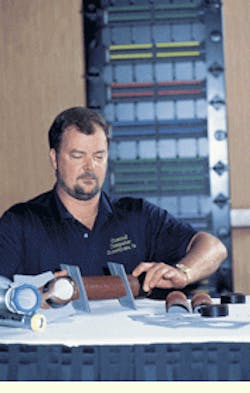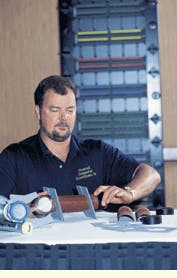Practical tips on firestopping help ensure its effectiveness
Mike Tobias, It`s Unique
Problem
Firestopping is such a hot issue now because cabling professionals have not been doing a very good job of it. Public-safety officials, fire marshals, and building inspectors want us to respect the firewall, which is designed to save lives and property in the event of a fire. However, there is some confusion as to how to properly firestop a cabling installation.
Solution
The National Electrical Code (nec) clearly states that metallic conduit be installed in vertical penetrations of fire barriers. The conduit sleeve has a fill capacity--usually under 50%--and the resulting void must be filled with fire-dam caulk or putty. There should also be backing for intumescent material to expand against. (Intumescent material expands in the presence of heat.) Installing cables in a core-drilled floor without the benefit of a metallic mechanical sleeve is a violation of the fire code.
The nec is less straightforward in dealing with horizontal penetrations of fire barriers: It stops short of calling for metallic conduit, but instead, specifies an "approved system." This can create confusion among low-voltage cabling installers, who may think that a tube of fire-dam caulk is, in itself, an approved system. This is not the case. Approved systems consist of installation guidelines as well as materials, and such comprehensive assembly instructions are rarely found on tubes of caulk.
Some firestopping tips
Here are some practical tips to consider when you are faced with firestopping a cabling installation:
- Does your company have a standard operating procedure for accomplishing this task? If not, one should be established; if you have one, it should be reviewed periodically.
- Firestopping procedures should explicitly follow manufacturers` instructions for products such as caulks and putties.
- Before beginning a job, contact the local building inspector and fire marshal to make sure you are complying with the fire codes in your area.
- Use a metallic system or conduit sleeve for both vertical and horizontal penetrations of fire barriers.
- Whatever firestopping method you employ, ensure that all materials and assemblies are approved by a nationally recognized testing facility.
- At the penetration, use indelible ink to record your company name, the date, and the number of cables penetrating the fire barrier. This will protect you if other companies open your firestop assembly and exceed its fill capacity or otherwise violate the fire code.
- Do not run new cables through existing violations of fire barriers. Some building inspectors will then hold you responsible for all cables in violation of the fire code.
- Do not caulk or "mud up" around your cables if the fill cavity exceeds the recommended limits. Minimum depth thickness is affected by the space to be packed.
- Do not exceed the fill capacity of a sleeve. Most caulks and putties are intumescent and will expand to seal the sleeve when exposed to heat. If a sleeve is approaching a fill level of 50%, install a new one.
- Remember to drill oversized holes for core-drilled conduit. For example, for a 4-inch sleeve, you need a 412-inch hole.
- Do not use regular insulation in place of mineral wool batt insulation for packing.
Ron Tobias of Coastal Computer Connections Inc. (Pensacola, FL) assembles a retrofit firestopping device invented by his brother, Mike Tobias, of It`s Unique (Mobile, AL).
Mike Tobias is the founder of Pensacola, FL-based Coastal Computer Connections Inc., a cabling contracting company. Recently, he also founded It`s Unique in Mobile, AL, a company that manufactures firestopping products for cabling contractors.

